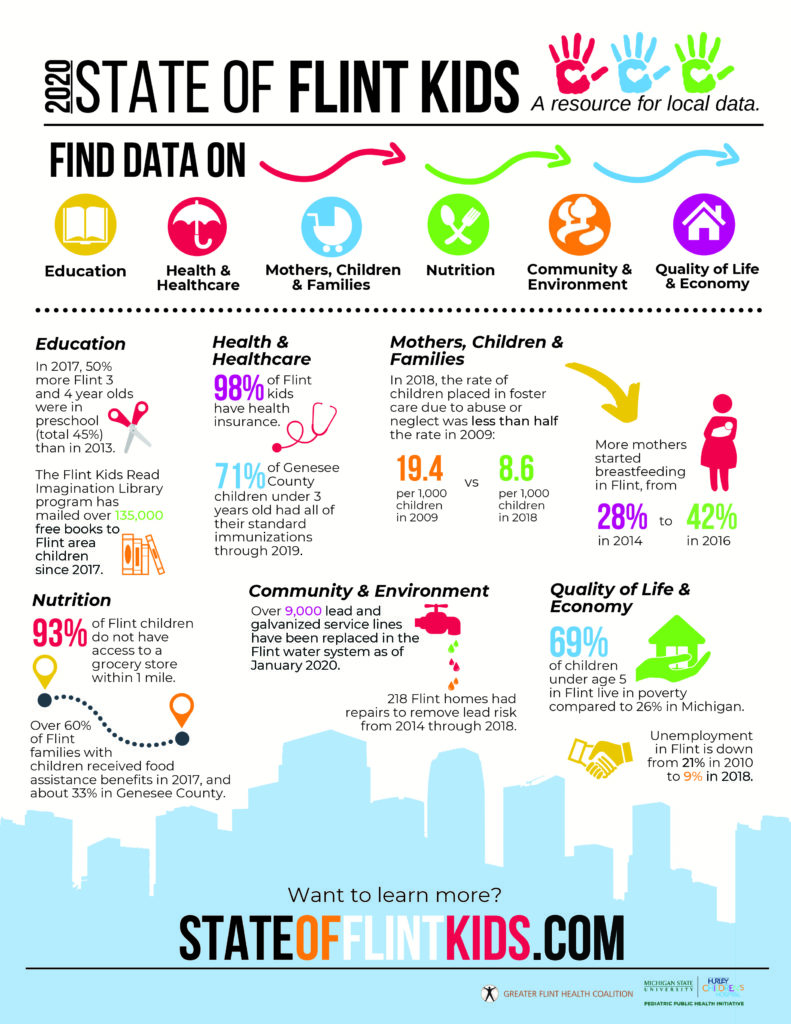By Coner Segren
The story of Flint in the past decade has largely been a tale of two cities. While the unemployment rate has fallen by more than half since 2010, 69 percent of Flint children under the age of 5 are living in poverty. And that is just one of the many challenges facing families in Genesee County in the wake of the Flint water crisis per a report presented by the Greater Flint Health Coalition at the first “State of Flint Kids” event Feb. 14.
“We’ve heard the State of the State, and we’ve heard the State of the Union,” said Dr. Mona Hanna-Attisha, one of the main speakers at the event, in a press release. “Now it’s time to hear about the State of Flint Kids.”

Mona Hanna-Attisha (Photo by Mike Naddeo)
Hanna-Attisha, a Hurley Medical Center pediatrician who played a key role in exposing lead levels of her young patients in the water crisis, said she intended for the event to showcase both the progress that has been made in the last few years, as well as some of the obstacles that remain for the health and wellbeing of Flint kids.
And indeed, the state of Flint kids is not all doom and gloom.
According to the data provided, 98 percent of Flint kids have health insurance, and 71 percent of Genesee County children under three have had all of their standard immunizations through 2019. More mothers started breastfeeding, to 42 percent in 2016, up from 28 percent in 2014. The rate of children placed in foster care due to abuse and neglect in 2018 was less than half the rate in 2009, down to 8.6 per 1,000 children from 19.4 per 1,000.
The report highlights several programs that have had success bringing a higher standard of living to families around Genesee County, including the Flint Kids Read program, which mails books to children to promote literacy, and has mailed out over 135,000 books to Flint area kids since 2017.
The Health Coalition found that 93 percent of Flint children do not have access to a grocery story within one mile. More than 60 percent of Flint families with children received food benefits in 2017; about 33 percent in Genesee County.
Doctors have also provided over 34,000 prescriptions since 2016 for healthy foods like fruit and vegetables that can be redeemed at the Flint Farmer’s Market. Good nutrition–specifically green vegetables–have been linked to reducing effects of lead exposure in children and others.
And, of course, more than 9,000 lead and galvanized water service lines have been replaced in infrastructure response to the water crisis.
There are certain numbers which may seem good on their face without telling the whole story, Hanna-Attisha suggested. While Flint’s unemployment rate has fallen from 21 percent in 2010 to 9 percent in 2018, one of the biggest challenges for Flint families highlighted in the report is the 69 percent child poverty rate compared with 26 percent for the state of Michigan overall.
Asked what might be causing such disparate numbers, Hanna-Attisha said that while there may be a greater number of jobs in Flint now, they do not pay living wages. “This is why the blueprint given out at the event advocates specific policy changes like raising the minimum wage, paid family leave, and subsidized child care,” she said.
Hanna-Attisha appealed specifically to Flint history when stressing the need for better paying jobs.
“This is what Flint is famous for. Flint is the birth place of the middle class, and it was because of our workers in the auto industry. We are advocating for things like raising the minimum wage, so having a job, a living wage job comes with benefits and everything you need to support your family.”
Sharon Swindell, M.D., gave the keynote address on “The State of Michigan’s Kids: Blueprint for Children.” She is the president of the Michigan Chapter of the American Academy of Pediatrics, a pediatrician at C.S. Mott Children’s Hospital, and an advocate for children exposed to lead poisoning.
Swindell and others stressed the need for the state and federal governments to take action with specific policy goals. Besides the main presenters, the event was attended by several high-profile officials, including State Senate Minority Leader Jim Ananich and Mayor Sheldon Neeley, both of whom spoke, as well as representatives from the offices of U.S. Rep. Dan Kildee and U.S. Sen. Debbie Stabenow.
Sen. Ananich, who is also chair of the Greater Flint Health Coalition, pointed to the rise of low paying service sector jobs as being a driver of poverty in Genesee County. One solution the senator promoted was increased funding for education in Gov. Gretchen Whitmer’s budget, especially advocating for programs like universal pre-K.
“The governor’s budget does a good job of providing services not just for Flint, but for all schools, making sure our schools are on a path to success. Instead of just tracking failure, we are promoting success, and I think a lot of that is giving people the skills and the preparation so that they go to a 2-year program or a training program or a 4-year program,” Ananich said.
“If we get the governor’s budget, something I have advocated for a long time is universal pre-K. Every kid in Flint will have access to quality universal pre-K programs. I think a lot of these things are bi-partisan–they’re not really partisan issues.”
Ananich also explained that another motivating factor in presenting this information to the public was one of transparency. He criticized the Snyder administration specifically for what he characterized as their lack of transparency in their handling of the water crisis, calling most of their outreach “a PR campaign, not a public health concern.”
This emphasis on transparency and openness echoes the comments of Hanna-Attisha on the lasting impact of the water crisis on public health. Both called it “a trauma.”
“We have holistically looked at this water crisis as a trauma,” she said. “A trauma in regards to lost trust and betrayal.”
Both were asked if they believe the crisis to be “over,” and if not, how the community might recognize when it is. While both Hanna-Attisha and Ananich were hesitant to say definitively what metric could be used to judge such a thing, they both cited the lost trust the community has in its leaders and the emotions of betrayal surrounding it as a public health issue on its own. Ananich compared it to post-traumatic stress.
He ultimately concurred with a statement by Hanna-Attisha. “The crisis will be over when there is an element of justice, when accountability has happened,” she said. “Accountability and restorative justice are crucial for healing. When we have a long-term commitment to recovery.”
Dr. Hanna-Attisha cited the tasks of restoring that trust and the sustainability of the programs already in place as two of the biggest challenges facing both citizens and leaders in Genesee County going into 2020.
However, when asked what trend or sign she found most encouraging, Dr. Hanna-Attisha cited the kids from the Flint Youth Justice League who opened and closed the event, as well as Flint kids in general.
“It was another opportunity to get re-inspired by our kids, another opportunity to remember why we do this work. They center us, they ground us, they are brilliant, they are brave, they are strong, they are resilient, and it was a reminder that with these kids at our side… we have to double down our efforts on their behalf and with them to continue this work.”
More information from the report is available at StateofFlintkids.com.
EVM Staff Writer Coner Segren can be reached at csegren@umich.edu.




You must be logged in to post a comment.